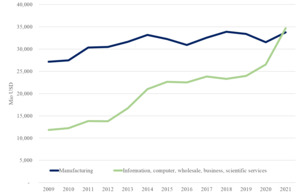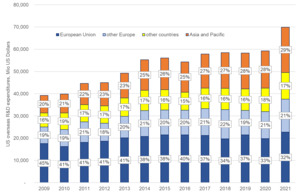Introduction
The multinational enterprise (MNE) as we know it today is, to a large extent, the product of the application of new knowledge and technologies. In their pursuit of knowledge, MNEs often extend beyond their home country, establishing research and development (R&D) activities abroad, creating the internationalization of R&D (Papanastassiou, Pearce, & Zanfei, 2020).
R&D investments by US MNEs in the European Union and vice versa dominated the internationalization of R&D for the past 30 years. The European Union is still an important location, but overseas R&D of US MNEs today is growing faster elsewhere, particularly in Asia. This is, among other factors, a result of the growing scientific capabilities of emerging economies, but also of digitalization and the emergence of digital MNEs, two trends that are expected to shape the future of R&D internationalization (Dachs, Amoroso, Castellani, Papanastassiou, & von Zedtwitz, 2024). This paper makes the point that this geographical reorientation is closely linked to a shift towards the service sector, driven by new digital technologies. Data indicate that, during the 2020s, services have replaced manufacturing as the most dynamic sector in R&D internationalization, and US service MNEs seem to exhibit a preference for locating their investments in Asia.
Data
The analysis employs data on the activities of multinational enterprises collected by the U.S Bureau of Economic Analysis (BEA, 2023). Activity data are based on an annual firm-level survey of both foreign affiliates of US multinationals and their parent companies, thus complementing foreign direct investment data from international financial transactions, or announcements of investment projects. The paper utilizes data on R&D expenditures of majority-owned foreign affiliates broken down by host country and by industry of the affiliate. Data are provided in nominal US dollars.
The Sectoral Shift
The internationalization of R&D started in the 1960s, with overseas R&D investments of US MNEs in the automotive, chemicals, pharmaceuticals, and electrical. Services – often location-bound and difficult to export – had minor impact on internationalization during this period.
Sixty years later, the picture has changed completely. While R&D investments in manufacturing abroad have been growing slowly after the Global Financial Crisis of 2007/08, R&D in the five main service sectors – wholesale, information, computer, business and scientific services – have more than tripled outside the US (Figure 1).
The reasons behind this change are manifold, as the service sectors are quite heterogenous. Digitalization has been an important driver; it has enabled firms to provide their services in digital form over the Internet, and has reduced trade costs for these services to almost zero. Digital technologies have also incentivized the creation of a new type of multinational enterprise: digital MNEs (UNCTAD, 2017), which are increasingly R&D-intensive. Recent company-level data indicate that digital MNEs are among the largest corporate R&D investors (Nindl et al., 2023). Alphabet, Meta, and Microsoft are currently the three companies with the highest R&D expenditures globally; the top 50 corporate R&D investors include nine software and computer services companies.
Digital MNEs benefit from new entry modes into foreign markets, such as virtual presence, where MNEs leverage their firm-specific advantages with very little physical presence abroad (Brouthers, Chen, Li, & Shaheer, 2022). As a result, digital MNEs tend to have few foreign assets, relative to foreign sales, unlike MNEs in traditional sectors (UNCTAD, 2017).
The rise of services also reflects a growing convergence between manufacturing and service industries. Services are increasingly employed as inputs in manufacturing global value chains, and manufacturing firms produce services to complement their main output (e.g., Miroudot & Cadestin, 2017). In some sectors, specialized service suppliers for manufacturing have emerged. Examples are contract R&D services in pharmaceuticals, or outsourced computer and information services.
Sectors and Countries
Further assessment of changes in the sectoral distribution of US R&D activities abroad provides an index of revealed comparative advantage (RCA). The RCA index relates the share of R&D expenditures (X) of a particular industry (i) in a particular country (j) to the corresponding world-wide share of this activity. The index is defined as follows:
\[RCAij = \frac{X_{ij} / \sum_{j} X_{ij}}{\sum_{i} X_{ij} / \sum_{i} {\sum_{j} X_{ij}}}\]
This index is larger than one if the services specialization of US affiliates in a particular country is higher than the world average. Services considered include information, wholesale, business, scientific, and computer services. Figure 2 depicts results for 2009-2021 reflecting the European Union, other Europe, Asian, and other non-European countries.
RCA values for Asian countries, other European (dominated by the UK and Switzerland), and non-European countries are above one which suggests specialization in services. There is, however, some convergence towards one, which means that specializations may be decreasing over time. Values for the European Union, in contrast, are below one for the entire period, indicating a lack of specialization on services. The poor performance of the European Union is mainly a result of the low service specialization found in Germany, Italy, and France, which are the largest member states.
The data also reveal interesting details on country specialization, displayed in Figure 3, which compares RCA values for 2015 and 2021. Countries specialized in services, as indicated by an RCA value of one or higher, are India, Israel, and Switzerland. The UK is a preferred location for the European headquarters of US multinationals, and the accompanying headquarter-oriented services including R&D. The data give no indication that the UK’s exit from the European Union (Brexit), has led to substantial shifts of these activities to continental Europe. On contrary, the RCA value for the UK increased between 2015 and 2021.
China hosts approximately equally absolute volumes of services and manufacturing R&D, while India is the predominant host country for service R&D by US firms in Asia, hosting nearly half of such activities in the region. Asia reveals a higher services specialization than the European Union, but not all Asian countries are specialized in services; service shares are considerably lower in Singapore and South Korea than in India or China. Japan is an example of a country that changed its specialization from manufacturing to services R&D, with corresponding rising RCA values; starting from very low levels in 2009, in 2021 Japan hosted more US R&D in services than in manufacturing.
Countries with high service sector RCA values reveal a higher average growth rate of R&D expenditures by US-owned affiliates in these countries. R&D expenditures by US firms increased by 39% over the period 2015-21 for the first 14 countries in Figure 3, but only 21% for the next 14 countries. Thus, a stronger service specialization in 2015 is related to faster overall growth of R&D expenditures during the following six years.
The rise of services R&D was accompanied by changes in the relative importance of different host countries for R&D by US multinationals. As shown in Figure 4, the share of the European Union – with its specialization on manufacturing R&D - has dropped by more than 10 percentage points during the last 12 years. This does not imply a decrease in spending. In absolute terms, R&D expenditures by US multinationals have increased in all regions, but these expenditures rose much faster in Asia/Pacific, leading to a shift in the relative shares from the EU to Asian countries (Figure 4).
One explanation for this trend are the growing scientific and technological capabilities in many Asian countries. Digital MNEs tend to sell highly standardized services online, so market adaptation and market growth seem less relevant than knowledge-seeking and knowledge-related locational factors, including proximity to excellent universities, pools of specialized labour, or partners for local cooperation. In fact, Asian scientific output (excluding Japan) has increased much faster than in the United States or Europe (National Science Board, 2021). Moreover, scientific publications in engineering, computer and information sciences are overrepresented in China and India compared to other disciplines, which benefits digital MNEs.
Conclusions
The paper has analyzed overseas R&D expenditures of US multinationals. For the first time, US MNEs abroad are spending more on services-related R&D than on R&D in manufacturing activities. At first, this observation challenges our understanding of the internationalization process of corporate R&D, which is inextricably connected to the automotive, the pharmaceutical, and the electronics industries. However, today, Google, Amazon, Microsoft, and Meta – not Pfizer, General Motors, and General Electric – are pushing forward R&D internationalization. This fits with the observation of the rapid growth of digital MNEs, and the rise of global trade in services in general. There is little doubt that this trend will continue in the future, although potential obstacles may be the techno-nationalism that can be observed in some countries, and growing geo-political tensions (Dachs et al., 2024).
The question arises as to whether US multinationals are exceptions or if they represent a general trend. Data from the largest R&D-performing MNEs (Nindl et al., 2023) indicate that US firms dominate digital services; only China was able to establish notable competitors, while the R&D investments of European and Japanese digital MNEs remain small. A definitive answer to this question, however, is difficult to find, since some statistical offices – including the Statistical Office of the European Commission, EUROSTAT – do not collect this data for services.
The results can also be read as an indication that some countries struggle with structural transformation towards the digital economy. However, the data do not reveal the precise content of R&D activities, just the sectoral affiliation of the R&D-performing MNE affiliate. Digital technologies have also become very important for a number of manufacturing industries, including automotive and machinery, and much of the R&D in these sectors already deals with digitalization. In addition, the activities and performance of foreign subsidiaries are the result of their own choices and the degree of autonomy that they enjoy, particularly when it comes to R&D. Thus, current specializations are also a result of past success. Countries specialized in manufacturing R&D still can offer a lot to US MNEs. The long-term challenge for these countries is that they are not specialized in the sectors in which R&D investments are growing most rapidly.
About the Author
Bernhard Dachs is Senior Scientist at the Center for Innovation Systems and Policy of AIT Austrian Institute of Technology, Vienna, Austria. His areas of expertise are the economics of innovation and technological change, in particular with regard to the internationalisation of R&D, innovation processes in firms, and the analysis of national and international technology policy. To date, his work has been mostly empirical and applied. His research has been published in a number of international peer-reviewed journals.
Funding
This work was supported by Horizon Europe of the European Commission under Grant agreement ID101056793.


_for_service_sectors__2009--2021.png)



_for_service_sectors__2009--2021.png)

